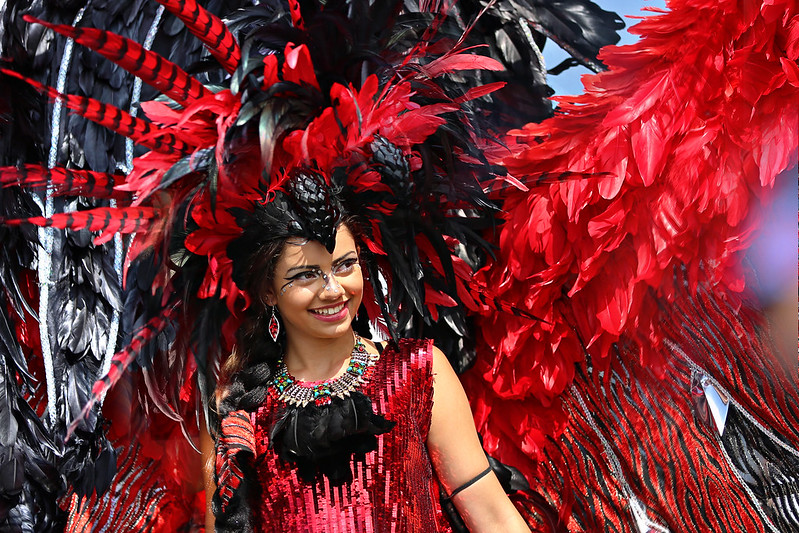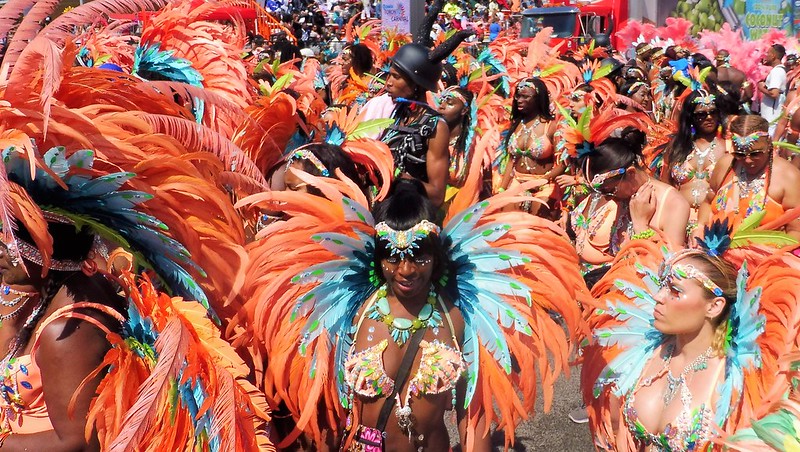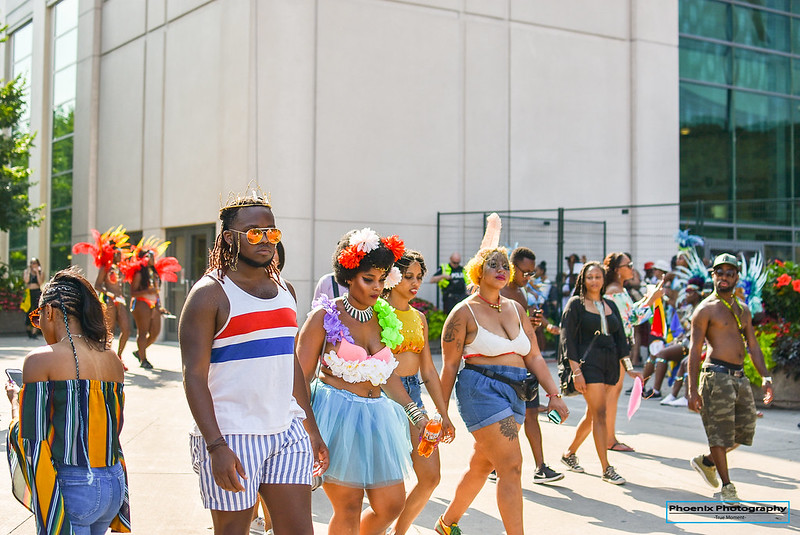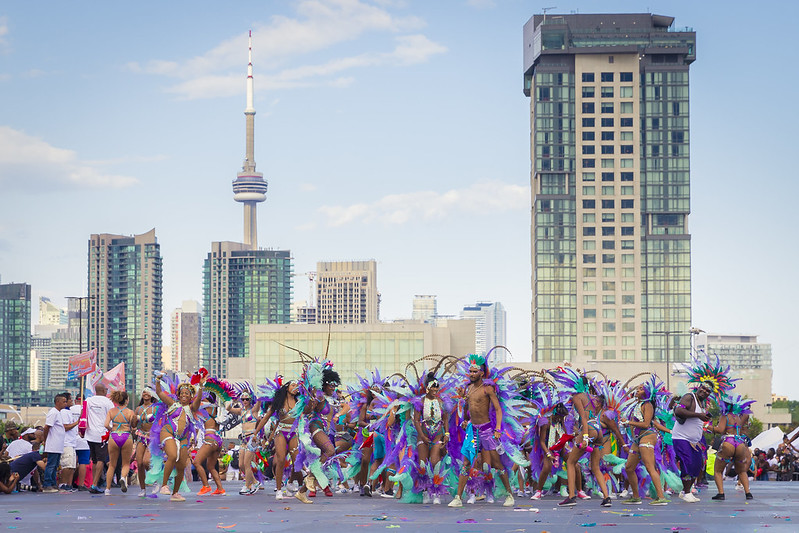Caribana (Toronto Caribbean Carnival)
Toronto’s Carnival of Caribbean Colour, Rhythm, and Pride
2026/07/22 - 2026/08/02
Every summer, Toronto bursts into a sea of Caribbean colour, music, and aromas for Caribana (officially the Toronto Caribbean Carnival). From late July to early August, this three-week festival draws over a million people, making it the largest Caribbean cultural festival in North America. Whether you’re a first-timer or a seasoned “feter,” everyone is invited to dance in the streets, savour Caribbean flavours, and experience Toronto at its most vibrant and alive.
The festival’s highlight is the Grand Parade, when Lake Shore Boulevard transforms into a wave of feathers, sequins, and music. Mas bands, steelpan orchestras, and dancers celebrate freedom, self-expression, and tradition. Caribana is a living celebration of Caribbean pride, resilience, and joy-open to all who want to join the party.
Main Attractions
Spectacular! The Grand Parade & the Energy of “Playing Mas”
The heart of Caribana is the Grand Parade. Mas bands (costumed dancer groups) parade all day to the sounds of soca, calypso, reggae, and steelpan. From the extravagant “Front Line” costumes with feathers and jewels to the more mobile “Back Line,” each tells a story, and spectators join in by dancing, taking photos, and soaking up the excitement.
Competitions like Band of the Year, King & Queen Show, and Junior Carnival add to the thrill. The King & Queen Show features massive, artistic costumes-some so large they require wheels. The Junior Carnival is a parade for children, while J’ouvert, the pre-dawn paint party, is a chaotic, joyful explosion of colour and music.
Caribbean Nights Never Sleep! Fetes, Nightlife & Culture Everywhere
Caribana is more than just the parade. Fetes (parties), concerts, pool parties, and club nights pulse through the city. Soca, dancehall, hip hop, and R&B fill Toronto’s nights with Caribbean energy. By day, there are food festivals, art exhibits, and steelpan competitions. At Marilyn Bell Park and Harbourfront, you’ll find markets, dance shows, concerts, and family activities.
Vivid Artistry! One-of-a-Kind Costumes & Street Decorations
Costumes are the soul of Caribana. Feathers, sequins, beads, and dazzling colours-many are handmade over the course of a year, with each band competing in creativity and energy. Spectators join in with flags, face paint, and Caribbean colours, while banners, food stalls, and the aroma of jerk chicken and spices line the parade route.
A Feast for the Senses! Street Food & Tropical Drinks
Caribana is also a culinary celebration. Food stalls serve jerk chicken, roti, doubles, black pudding, rum cake, and more Caribbean classics, along with popular drinks like sorrel, mauby, and rum punch. The air is thick with the scent of spices, charcoal, and baked goods, while music and laughter fill every corner.
Cultural and Historical Background
Caribana began in 1967 as a “gift” from Toronto’s Caribbean community to celebrate Canada’s centennial, but it quickly became an annual tradition and a symbol of Toronto’s multicultural identity. Its roots lie in Trinidad and Tobago’s Carnival, as well as traditions from Jamaica’s John Canoe, Barbados’ Crop Over, Haiti’s Carnival, and other Caribbean festivals-each blending African, Indigenous, and European influences into a unique cultural tapestry.
Caribana’s spirit is deeply connected to the history of emancipation and the struggle for freedom. Throughout the Caribbean, Emancipation Day (August 1) is celebrated with masquerade parades, music, and dance, expressing freedom and pride. In Trinidad, Carnival was originally a festival for the White French and Creole elite, but enslaved Africans developed their own parallel celebrations-canboulay-using masks, music, and costumes to express resistance and identity. After emancipation, these traditions flourished, becoming powerful symbols of Afro-Caribbean pride and resilience, and forming the foundation for modern Carnival and Caribana.
In Toronto, Caribana was also shaped by Black Canadian history, including Emancipation Day parades and Calypso Carnivals organized by the Canadian Negro Women’s Association in the 1950s and 60s. In its early years (1967–1971), Caribana aimed to share West Indian culture with the wider community and support the creation of a permanent Caribbean cultural centre. Over the decades, it has grown from a three-day parade to a multi-week festival, now attracting over a million visitors-including international celebrities and Caribbean leaders-each year.
Despite financial and organizational challenges, Caribana is now North America’s largest Caribbean festival and a symbol of Caribbean diaspora pride, unity, and resistance to discrimination. For Toronto, it’s an open invitation to experience the city’s diversity and the enduring spirit of the Caribbean community.
Participant Voices
I joined as a spectator with friends and was swept up in the excitement alongside locals and tourists along the parade route. Halfway through, I struck up a conversation with the person next to me, who taught me about Caribbean culture and dance. It’s a festival where you don’t just watch-you truly feel like you’re part of it.
Fun Facts
- Caribana draws over a million visitors each year, making it the largest Caribbean festival in North America.
- J’ouvert is a pre-dawn paint party where you’ll leave covered in colour from head to toe.
- Caribana’s roots blend traditions from Trinidad, Jamaica, Barbados, Haiti, and more, fusing African, Indigenous, and European influences.
- Signature foods include jerk chicken, roti, doubles, black pudding, and rum cake.
Festival Dates
Caribana is held every year in Toronto, with the main event being the Grand Parade along Lake Shore Boulevard. Join a Mas band, don your feathers, and let the rhythms of the Caribbean carry you through the heart of Toronto’s summer.
The event schedule is subject to change. Please check the official website for the most up-to-date information.
Information
| Name | Caribana (Toronto Caribbean Carnival) |
| Country | Canada |
| Area | |
| Date | 2026/07/22 - 2026/08/02 |
| Link |
Upcoming Festivals
Whirling Dervishes Festival Turkey
A Mesmerizing Dance of Divine Love
2025/12/06Mevlana Celaleddin Rumi Commemoration Ceremony ( Şeb-i Arus ) Turkey
A Whirling Journey to Divine Love
2025/12/10Dia de la Virgen de Guadalupe Mexico
A Festival Weaving Faith, Fervor, and Mexican Identity
2025/12/11L'Escalade Switzerland
Geneva’s Grand Winter Festival of Courage, Chocolate, and Community
2025/12/12Umkhosi Wokweshwama South Africa
The Zulu First Fruits Festival—A Sacred Celebration of Land, Ancestors, and Renewal
2025/12/12Lucia Festival (St. Lucia's Day) Sweden
A Festival of Light Illuminating the Nordic Darkness
2025/12/15Las Posadas Mexico
The Luminous Quest for Sacred Shelter
2025/12/22Noche de Rabanos (Night of the Radishes) Mexico
A celebration blending art, farming heritage, and cultural traditions
2025/12/23Chant of the Sybil on Majorca Spain
A Medieval Prophecy Echoes Through Majorcan Christmas
2025/12/23‘Hatajo de Negritos’ and the ‘Hatajo de Pallitas’ Peru
A Christmas Festival of Rhythm, Faith, and Afro-Andean Heritage in Peru’s Ica Region



